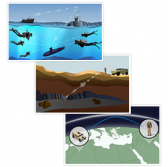 The Defense Advanced Research Projects Agency has asked industry to submit research proposals for a $23 million program that seeks to develop low-size, weight, and power transmitters that will work to facilitate underground and underwater radio communications.
The Defense Advanced Research Projects Agency has asked industry to submit research proposals for a $23 million program that seeks to develop low-size, weight, and power transmitters that will work to facilitate underground and underwater radio communications.
DARPA posted on FedBizOpps the broad agency announcement for the A Mechanically Based Antenna program that seeks to create transmitters designed to produce radiofrequency signals at frequencies below 30 kilohertz, the agency said Friday.
According to the BAA, the AMEBA program is a 45-month initiative that is composed of two technical areas.
The first technical area will focus on transmitters designed to penetrate ultra-low-frequency electromagnetic waves below 3 kHz and can be used in underwater and through-ground communications, while the second technical area will deal with the development of very-low-frequency systems that operate between 3 and 30 kHz frequency range and over long distances.
“Mobile low-frequency communication has been such a hard technological problem, especially for long-distance linkages, that we have seen little progress in many years… With AMEBA, we expect to change that,†said Troy Olsson, program manager at DARPA’s microsystems technology office.
The agency said it will host a Proposers Day on Jan. 6 in Virginia and will accept proposals for the program through March 22.




